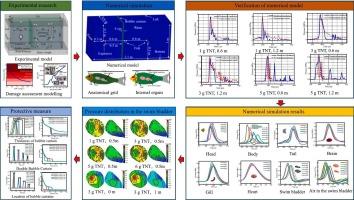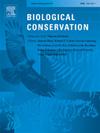鱼鳔在水下爆炸时的动态行为和减轻伤害的方法
IF 4.9
1区 环境科学与生态学
Q1 BIODIVERSITY CONSERVATION
引用次数: 0
摘要
暗礁挖掘和近海采矿等水下爆破活动不可避免地会影响水生生物,尤其是鱼类。然而,很少有研究关注水下爆炸对附近鱼类造成的伤害。本研究进行了水下爆炸实验,以调查水冲击波对鲫鱼伤害的影响。通过比较爆炸前后鱼类的外观损伤和活动能力,并将解剖结果与鱼类所在位置的峰值压力相结合,全面分析了水下爆炸对鱼类的具体损伤机制。此外,还建立了基于流固耦合方法的数值模型,以研究鱼类在水下爆炸时的动态行为。最后,分析了气泡幕对水冲击波传播的衰减作用。研究发现,鱼鳔破裂是导致鱼类死亡的主要原因。鳔破裂的临界峰值压力被确定为 9.8 兆帕。根据实验得出的峰值压力和解剖结果,对伤害等级进行了细致的分类:压力低于 3.2 兆帕时为无伤害,压力为 3.2-5.2 兆帕时为轻微伤害,压力为 5.2-7.5 兆帕时为中度伤害,压力为 7.5-9.8 兆帕时为重度伤害,压力超过 9.8 兆帕时为极重度伤害。此外,在气泡幕的保护下,实验中鲫鱼两个测量点的峰值压力分别从 13.5 兆帕和 6.7 兆帕显著下降到 2.4 兆帕和 0.6 兆帕。鱼类受伤程度从极重和重伤变为无伤,这表明气泡幕是一种有效的缓解措施,可减少水下爆炸对鱼类的影响。本文章由计算机程序翻译,如有差异,请以英文原文为准。

Dynamic behaviour of fish with swim bladders subjected to underwater explosions and methods for mitigating injuries
Underwater blasting activities such as reef excavation and offshore mining inevitably affect aquatic organisms, particularly fish. However, few studies have focused on damage induced by underwater explosions on nearby fish. In this study, underwater explosion experiments were conducted to investigate the effects of water shock waves on crucian carp injuries. By comparing the cosmetic damage and mobility of the fish before and after the explosion and combining the anatomical results with the peak pressure at the location of the fish, the specific damage mechanisms of underwater explosions on fish were comprehensively analysed. Additionally, a numerical model based on the fluid–solid coupling method was developed to study the dynamic behaviour of fish subjected to underwater explosions. Finally, the attenuating effect of bubble curtains on the propagation of the water shock wave was analysed. Rupture of the swim bladder was found to be the primary cause of fish mortality. The critical peak pressure for swim bladder rupture was determined as 9.8 MPa. Based on the peak pressure obtained from experiments and autopsy results, the injury grades were meticulously categorised as follows: no injury for pressures below 3.2 MPa, slight injury for pressures of 3.2–5.2 MPa, moderate injury for pressures of 5.2–7.5 MPa, serious injury for pressures of 7.5–9.8 MPa, and extremely serious injury for pressures over 9.8 MPa. Furthermore, under the protection of a bubble curtain, the peak pressures at the two measurement points for crucian carp in the experiment significantly decreased from 13.5 MPa and 6.7 MPa to 2.4 MPa and 0.6 MPa, respectively. The degree of fish injury changed from extremely serious and serious injuries to no injury, demonstrating that bubble curtains serve as an effective mitigation measure to reduce the impact of underwater explosions on fish.
求助全文
通过发布文献求助,成功后即可免费获取论文全文。
去求助
来源期刊

Biological Conservation
环境科学-环境科学
CiteScore
10.20
自引率
3.40%
发文量
295
审稿时长
61 days
期刊介绍:
Biological Conservation is an international leading journal in the discipline of conservation biology. The journal publishes articles spanning a diverse range of fields that contribute to the biological, sociological, and economic dimensions of conservation and natural resource management. The primary aim of Biological Conservation is the publication of high-quality papers that advance the science and practice of conservation, or which demonstrate the application of conservation principles for natural resource management and policy. Therefore it will be of interest to a broad international readership.
 求助内容:
求助内容: 应助结果提醒方式:
应助结果提醒方式:


